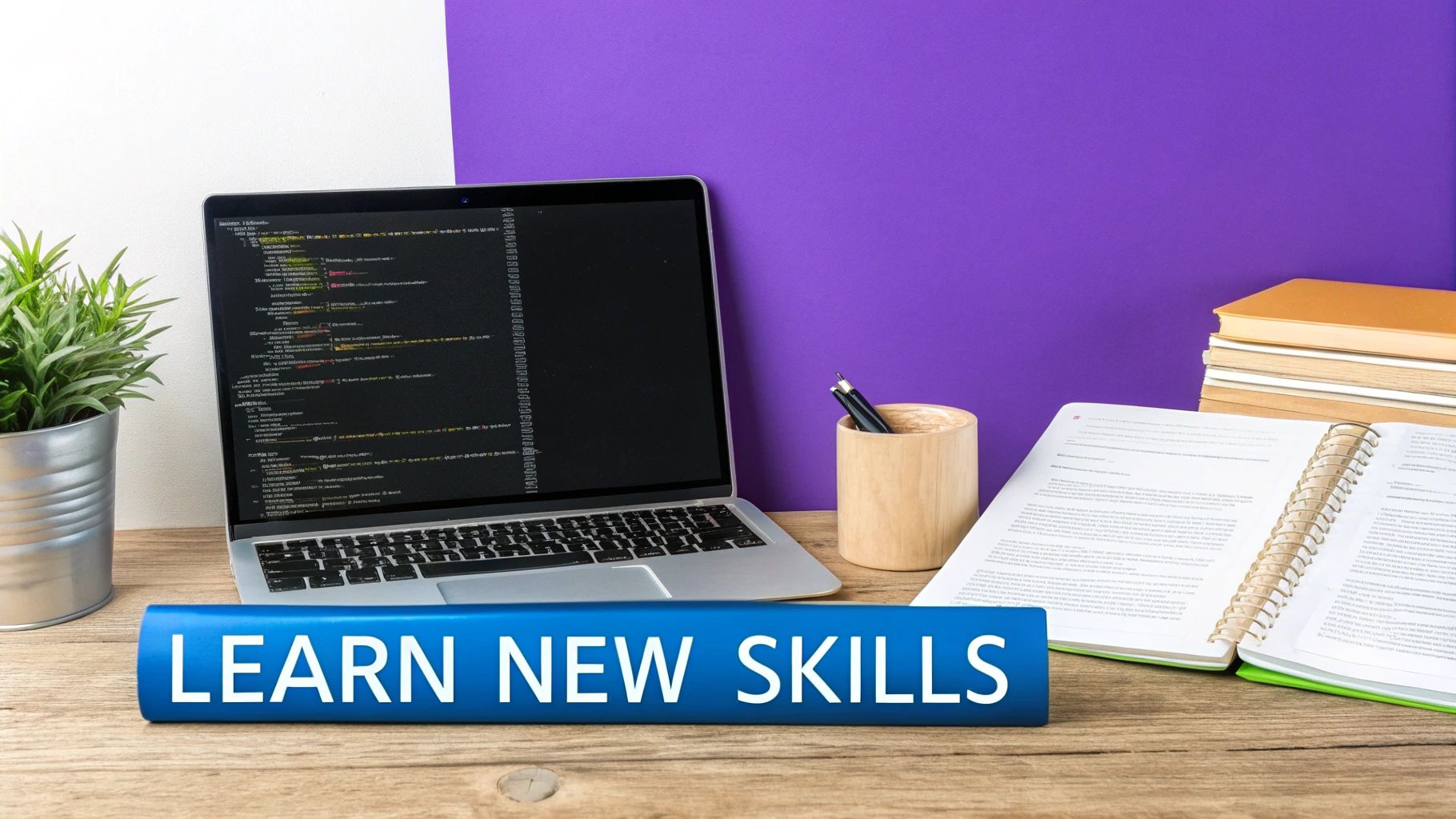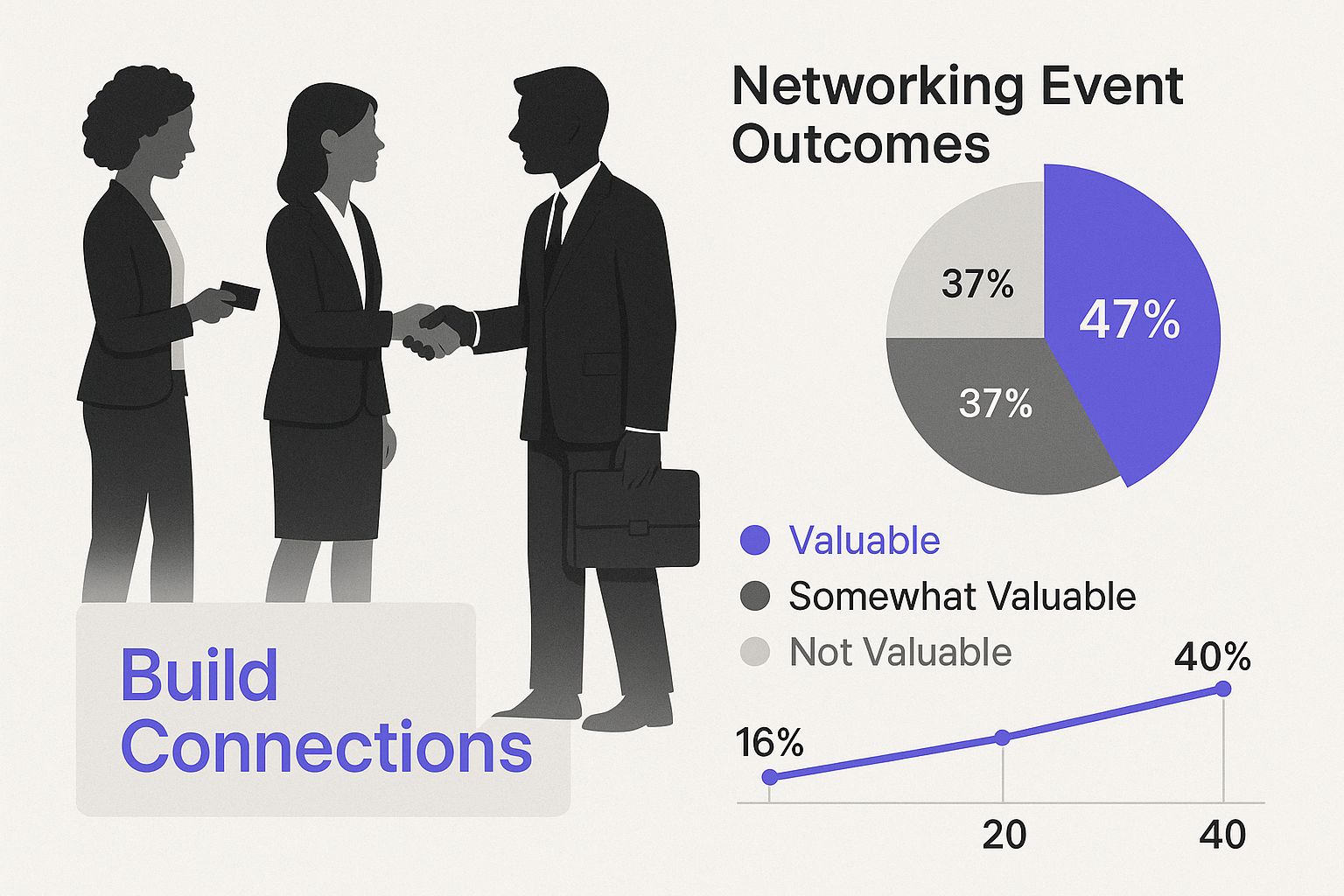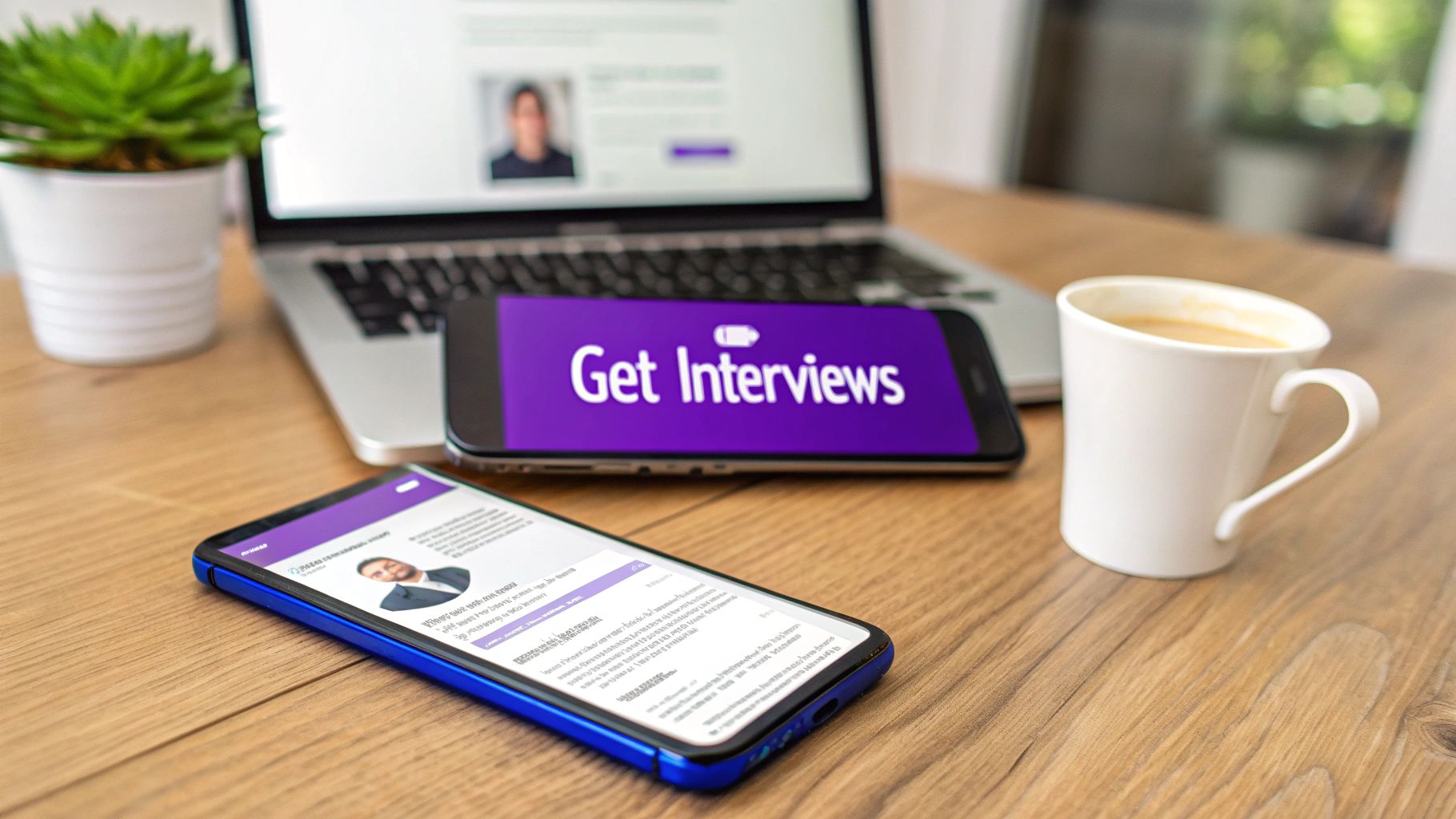How to Change Career Paths A Practical Guide

Thinking about a career change is a huge step. It’s more than just browsing job boards; it's a careful process of looking inward, exploring what’s out there, building new skills, and making the right connections. It all starts with getting brutally honest about why you're unhappy in the first place, then finding a new direction that actually lines up with what you want out of life.
Is It Time for a Career Change?

We’ve all been there. The Sunday scaries, that constant feeling of watching the clock, the nagging thought that you’re meant for something more. These are the classic signs telling you a change might be needed.
But hold on. Before you start firing off applications, the most important thing you can do is figure out the real source of your unhappiness. Just jumping ship without that clarity is a recipe for ending up in the same boat, just with a different logo on the side.
Think of this first phase as a personal audit. You're hiring yourself as a consultant to analyze your own career. The goal is simple: separate the temporary frustrations from the deep-seated issues that won't go away.
Pinpointing the Real Problem
So, where do you start? Begin by asking yourself some tough questions. Is it the actual work you do every day that you can't stand, or is it the toxic company culture that’s draining your soul? Maybe you've just fallen out of love with the industry, or perhaps all you really need is a manager who actually listens.
People often make a change for a few common reasons:
- Misaligned Values: The work you’re doing just doesn’t sit right with you. It might conflict with your ethics, your desire to make an impact, or your need for creative freedom.
- Poor Work-Life Balance: Your job is constantly bleeding into your personal time, leaving you feeling completely fried.
- Stagnant Growth: You’ve hit a dead end. There's no clear path forward, no new skills to learn, and no room for advancement.
- Lack of Fulfillment: Let's be honest, the work just feels pointless. It doesn’t give you that sense of purpose you’re craving.
This self-reflection is everything. For instance, if you realize the problem is a horrible boss, finding a new job in the same field but at a better company could be the perfect fix. But if you discover that you just don't care about the industry's mission anymore, it's time for a much bigger pivot. For more help figuring out where you stand, check out this guide on Is It Time For A Career Change.
To give this some structure, try using a simple framework to organize your thoughts.
Self-Assessment Framework for Career Changers
This table is designed to help you dig deep and identify the root causes of your job dissatisfaction. Use it to clarify what you're looking for next.
| Area of Evaluation | Questions to Ask Yourself | Example Reflection |
|---|---|---|
| Daily Tasks & Workload | What parts of my job do I enjoy? What parts drain my energy? Is the workload manageable or overwhelming? | "I love the problem-solving parts of my job, but I'm bogged down by administrative tasks 80% of the time. The workload itself is fine, though." |
| Company Culture | Do I feel respected and valued? Do my colleagues energize or exhaust me? Does the company's mission resonate? | "The culture is very cutthroat. There's no collaboration, and I feel like I can't trust my team. The company mission feels disconnected from reality." |
| Growth & Learning | Are there opportunities for advancement? Am I learning new skills? Does my manager support my development? | "I've been in the same role for five years with no promotion in sight. The company doesn't invest in training, and my skills feel outdated." |
| Compensation & Balance | Am I paid fairly for my contributions? Can I disconnect after hours? Does the job support my life outside work? | "The pay is decent, but I'm expected to be online late into the evening. I have no time for my family or hobbies, and I'm burning out fast." |
Going through these questions helps you move from a vague feeling of "I hate my job" to a specific diagnosis of what's actually broken.
You Are Not Alone in This Journey
If you're thinking about a career change, you're in good company. This is becoming a normal part of how we work today. In fact, the average person holds around 12 different jobs in their lifetime, and many of those involve a complete career pivot.
Recent data shows that 32% of people aged 25 to 44 thought about changing careers last year. The biggest drivers? A higher salary (39%), a genuine interest in a different field (21%), and better opportunities to move up (20%).
The fear of "starting over" is what holds most people back. But you need to reframe that thought. Every single skill you've learned and every experience you've had is a transferable asset. It all adds up to what makes you uniquely valuable, even in a brand-new field.
For those of us hitting mid-career, the thought of a pivot can feel even more intimidating. You worry about ageism, money, and whether you can even learn new tricks. These are all valid concerns, but with the right strategy, you can turn them into advantages. Our guide on making a successful career change at 40 offers specific advice for navigating this exact situation.
Ultimately, this first step is all about self-awareness. It’s about moving from a vague feeling of "I need something new" to a crystal-clear understanding of "This is what's missing, and this is what I need to find." That clarity will be your north star for every decision you make from here on out.
Discovering Your Next Career Move

Once you’ve figured out why you need a change, the next big hurdle is deciding where to go. This part can feel like you’re staring at a giant, unmarked map with a million possible destinations.
The trick is to start broad and slowly narrow things down. Don't just dive onto job boards—that comes later. For now, your mission is to gather intel, spot trends, and turn a massive list of possibilities into a handful of solid options.
The working world is always in motion. Technology and shifting priorities are constantly creating and eliminating jobs.
The World Economic Forum predicts that structural changes will create around 170 million new jobs between 2025 and 2030, while 92 million existing roles will disappear. That’s a huge shift, and it’s a big reason to look toward growing fields like tech, the green economy, and healthcare. You can see more on this in The Future of Jobs Report 2025 digest.
Starting Your Research Journey
First things first, create a "curiosity list." What industries or roles have you always found interesting, even if they seem totally out of left field? Maybe you're an accountant who’s secretly fascinated by UX design, or a retail manager who can’t stop reading about renewable energy.
Seriously, no idea is too weird at this stage. Just aim for a list of 5-10 potential areas you want to explore.
With your list in hand, it’s time to do a little digital digging. Hop on LinkedIn and search for people with job titles that catch your eye. Check out their career paths, the skills they list, and where they work. You're not trying to contact them yet—you're just getting a feel for what a real career trajectory looks like in these fields.
Industry-specific forums and subreddits are also gold mines. They offer an unfiltered peek into the daily grind of a profession—the good, the bad, and the boring. Pay attention to what people complain about and what they celebrate.
The Power of Informational Interviews
Online research is great, but it will only get you so far. The best insights come from talking to real people who are actually doing the jobs you're considering. This is where informational interviews become your secret weapon.
An informational interview is just a casual chat—not a job interview—where you get to ask someone about their work, industry, and career path. Most people are surprisingly happy to share their story, especially if you’re genuinely curious and respect their time.
Here's a simple way to get started:
- Find People to Talk To: Use your LinkedIn research to pinpoint 2-3 people in each field you're exploring. Aim for folks who are a few steps ahead of where you'd be starting.
- Send a Quick Message: Keep your outreach short and to the point. A simple connection request or message explaining your goal is all you need.
- Prep Your Questions: Don't wing it. Go in with a list of thoughtful questions that will help you understand the reality of the role.
An informational interview is your backstage pass to a potential new career. It’s where you learn about the unwritten rules, the true work-life balance, and whether the job is as glamorous as it sounds online.
Questions to Guide Your Conversations
When you land one of these chats, ask questions that dig deeper than a standard job description. You want to understand the human side of the work. As you gather notes, you might find that technology can help you stay organized. Our guide on the best AI tools for job seekers has some great apps for managing your notes and follow-ups.
Try asking questions like these to get the full story:
- What does a typical day or week really look like in your role?
- What are the most challenging parts of your job? And what are the most rewarding?
- Beyond what's on a job description, what skills are absolutely essential to succeed here?
- How do you see this industry changing in the next five years?
- If you were starting over in this field today, what would you do differently?
Doing this kind of hands-on research turns your career change from a blind leap into a smart, strategic move. You'll be making your decision based on real data and human experiences, not just a gut feeling or a polished job ad.
Building the Skills for Your New Path
Once you’ve pinpointed a promising new career, it’s totally normal to feel a mix of excitement and, let's be honest, a little bit of anxiety. The path is clearer, but a new question looms: "Am I actually qualified?"
For most people navigating a career change, the answer lies in strategically building a bridge from where you are to where you want to be. It’s not about starting from scratch. It’s about being smart and closing the gap. The first step is taking an honest look at your current abilities versus what your target role demands.
Performing a Practical Skills Analysis
Your first move is a skill gap analysis. Think of it like a personal audit. Grab a piece of paper or open a doc and create two columns. In the first column, jot down the key skills you already have—the ones right there on your resume.
Next, pull up 5-7 job descriptions for the role you’re aiming for. In the second column, meticulously list every required skill, software, and certification you see popping up again and again.
Now, compare the two lists. The skills in that second column that aren't in your first? That’s your gap. This isn’t a reason to panic; it’s your learning roadmap.
For example, a marketing manager who wants to become a data analyst will likely find their communication and project management skills are solid. But they're probably missing hard skills in SQL, Python, and data visualization tools like Tableau. This kind of focused analysis keeps you from wasting time on skills that won’t actually move the needle.
Choosing Your Learning Pathway
With a clear list of skills to tackle, the next question is how to learn them. The great news is you have more options than ever, fitting all sorts of budgets, timelines, and learning preferences.
Learning Pathways for Career Changers
Picking the right method to acquire new skills can feel overwhelming. This table breaks down the most common options to help you choose the best fit for your budget, timeline, and learning style.
| Method | Best For | Typical Cost | Time Commitment |
|---|---|---|---|
| Online Courses | Learning specific software or foundational knowledge on a budget. | $ - $$ | Low to Medium (Self-paced) |
| Professional Certs | Verifying specific skills for employers in fields like IT or marketing. | $$ - $$$ | Medium (Defined curriculum) |
| Bootcamps | Rapid, intensive skill acquisition for a fast transition. | $$$ - $$$$ | High (Full-time for weeks/months) |
| Self-Study/Projects | Highly motivated learners who prefer hands-on, practical application. | $ (or free) | Varies (Self-directed) |
No matter which path you choose, make sure it offers tangible projects or a portfolio you can show off to potential employers.
The goal isn't just to learn; it's to acquire skills that you can immediately apply and showcase. Choose a path that provides tangible projects or a portfolio you can present to potential employers.
And don't forget, soft skills are just as critical. While you're sharpening your technical know-how, make sure your communication skills are on point. Our guide on how to develop communication skills offers some great, actionable tips that apply to any industry.
This infographic really drives home the importance of building connections while you learn—a crucial piece of any successful career change.

As the image shows, skill-building and networking are two sides of the same coin. Doing one without the other just isn't as effective.
Gaining Hands-On Experience Before You Land the Job
Knowing the theory is one thing. Actually applying it is what builds real confidence and, more importantly, impresses hiring managers. You have to prove you can do the work, not just that you’ve read about it.
Luckily, you don’t need a full-time job to get this kind of experience. Here are a few ways to get your hands dirty and apply your new skills in a real-world context:
- Volunteer for a Non-Profit: So many charities need help with everything from social media marketing to managing their databases. It’s a fantastic way to build your portfolio while doing some good.
- Start a Side Project: Learning web development? Build a website for a friend's small business. Moving into content creation? Start a blog focused on your new industry. These projects are pure gold for your resume.
- Freelance on a Small Scale: Platforms like Upwork or Fiverr are great for picking up small, paid projects. Even a few successfully completed gigs can add a ton of credibility.
This is the stuff that transforms you from a "career changer" into a legitimate candidate. It proves your commitment, shows off your new skills, and gives you compelling stories to tell in your interviews.
Weaving Your New Professional Story
You’ve put in the work—exploring new fields and building fresh skills. Now for the make-or-break step: rebranding yourself. It's time to rewrite your professional narrative so recruiters see your career change not as a random leap, but as a smart, deliberate move that makes you a more valuable hire.
This is all about connecting the dots for them. Your past experiences, even the ones that feel miles away from your new goal, gave you a unique perspective and a powerful set of skills. Your job is to frame that journey as a strength, positioning you as a more dynamic and resourceful candidate than someone who took the straight-and-narrow path.
Frame Your Resume Around Transferable Skills
Your old resume? It won't cut it anymore. Instead of just listing job duties chronologically, your new resume needs to tell a story of what you're capable of now. The focus has to shift from what you did to what you can do in this new role.
Start by translating your past wins into the language of your target industry. For instance, a project manager pivoting to marketing shouldn't just say they "managed project timelines." That's too literal. They need to reframe it to showcase skills that matter to a marketing team:
- The Old Way: "Managed a team of 10 to deliver a new software feature on schedule."
- The New Way: "Led a cross-functional team of 10 to execute a multi-channel product launch, coordinating stakeholders and ensuring alignment with strategic marketing goals."
See the difference? The second version screams leadership, strategic thinking, and a clear understanding of marketing objectives. It bridges the gap between past experience and future value.
When you're switching careers, your resume stops being a historical document and becomes a marketing brochure for your potential. Every single bullet point should answer the hiring manager's silent question: "Why should I care about this for this job?"
Tune Your LinkedIn Profile for Your Future
Recruiters are going to look you up on LinkedIn—it’s often the first stop after they see your application. Your profile needs to shout, "I belong in this new industry," not whisper, "I'm trying to leave my old one." And the most critical piece of real estate is your headline.
Ditch generic phrases like "Seeking new opportunities in [New Field]." It just flags you as an outsider. Instead, build a headline that merges your ambition with your core strengths. Your headline is your digital handshake; learning how to craft a powerful LinkedIn profile headline is non-negotiable.
Here’s an example: a lawyer moving into tech policy could use something like this:
"Former Attorney | Passionate about building equitable tech policy and advocating for digital privacy."
This immediately tells the story of their pivot while spotlighting relevant expertise. If you're stuck, try a tool like MakerBox's LinkedIn headline generator to spark some ideas that blend professionalism with your new direction.
Don't stop at the headline. Your "About" section needs to tell a compelling story about your career change. Explain the why behind your pivot and directly connect your past skills to your future goals. And start acting the part—join groups in your new field and jump into conversations to show you're serious and already learning the ropes.
Write a Cover Letter That Connects the Dots
The cover letter is your secret weapon. It’s your one chance to control the narrative completely. While your resume shows the what, the cover letter explains the why. This is where you grab the recruiter by the hand and walk them from your seemingly unrelated past right to their job description.
Don't just rehash your resume. Use the cover letter to tackle the career change head-on and spin it as your unique advantage.
Let's look at a real-world example. Imagine a hospitality manager applying for a customer success role at a SaaS company.
- Weak Approach: "Though my background is in hospitality, I have excellent people skills that I believe will be valuable."
- Strong Approach: "For over a decade in luxury hospitality, my job was to anticipate guest needs and proactively solve problems before they even knew they had them. This deep-seated focus on client retention and satisfaction has perfectly prepared me to excel in customer success, where I can apply my skills in de-escalation, relationship-building, and identifying user pain points to drive product adoption and slash churn."
The strong approach doesn't apologize. It reframes the past experience as a rigorous training ground for the exact skills needed in the new role. It shows the transition isn't just a whim—it's a calculated move. By telling your new story with this kind of confidence, you turn your unique journey into your greatest asset.
Building Connections in a New Industry
Once you’ve sharpened your new skills and rebuilt your professional story, the next step is to start building a network in your target industry. It’s a common myth that networking is just about collecting contacts. The real connections, the ones that actually lead to opportunities, are built on genuine curiosity and mutual value, not just transactional exchanges.
This isn’t about starting from scratch. Your existing network is your launchpad, even if it feels completely unrelated to where you're headed. The idea is to strategically use the relationships you already have to build a bridge into your new field.
Leverage Your Current Network for a Warm Start
Before you even think about sending cold messages on LinkedIn, take a look at who you already know. Friends, former colleagues, even acquaintances from different fields can be surprisingly helpful. You’re not asking them for a job; you’re asking for information and introductions.
Start by mapping out who in your circle might have a connection, however distant, to your new industry. A simple, direct message can work wonders:
"Hey [Name], hope you're doing well. I'm exploring a career change into [New Industry] and was wondering if you know anyone working in that space. I'd love to learn about their experience with a quick 15-minute chat. Any introduction you could make would be a huge help!"
This approach is low-pressure, specific, and respects their time, making it easy for them to help you out. The goal here is to turn what would be a cold outreach into a warm, friendly conversation.
Making Meaningful Connections Online
After tapping into your existing network, it’s time to branch out. Platforms like LinkedIn and industry-specific online communities are your best friends here. But your approach has to be about giving more than you take.
Instead of just blasting out connection requests, try these strategies:
- Engage with their content. Follow key people and companies in your target field. Leave thoughtful comments on their posts that actually add to the conversation.
- Join relevant groups. Jump into discussions, ask smart questions, and offer insights from your unique background.
- Share your learning journey. Post about a new skill you’re picking up or a project you’re working on. This positions you as a proactive, passionate learner.
Building authentic professional relationships takes time and consistent effort. You're not just networking; you're becoming a visible and valued member of a new professional community. To dig deeper into this, our guide on how to build professional relationships provides even more strategies.
Turning Cold Outreach into Warm Conversations
When you do reach out to someone new, your message has to stand out from the noise. Generic templates get ignored. The key is personalization and a clear, respectful request. A successful cold message should always include three things:
- A specific compliment. Show you’ve done your homework. Mention a recent project they worked on, an article they wrote, or something from their profile that impressed you.
- A brief intro. Quickly explain who you are and why you're reaching out—specifically, that you're transitioning into their field.
- A simple, time-bound request. Ask for a "15-minute virtual coffee chat" to hear about their experience, not to ask for a job.
This formula shows genuine interest and respect for their time, which dramatically increases your chances of getting a positive response.
The drive to change career paths is more common than ever, especially as people rethink what they want from their work. Recent trends show a huge part of the workforce is actively looking for a change. A 2025 FlexJobs report found that 62% of white-collar workers would consider moving to a trade or blue-collar job for better stability and pay, while 45% are interested in switching fields entirely. This widespread desire for change is often fueled by frustrations with stagnant wages and a tough job market. You can read more about these insights on the shifting American workforce on Fortune.com.
Your ability to connect with people who are already where you want to be can speed up your transition more than almost anything else. Every conversation is a chance to learn, get feedback on your new story, and uncover opportunities you’ll never find on a job board. Focus on quality over quantity, and you'll build a network that will support your career for years to come.
Answering the Tough Questions About Changing Careers
Let's be real: navigating a career change is full of "what ifs." It's completely normal to have a long list of questions keeping you up at night. Instead of letting them swirl around, let's tackle the biggest ones head-on.
Getting these anxieties out in the open is one of the most important steps you can take. It gives you the clarity you need to actually move forward.
How Do I Handle a Potential Pay Cut?
The fear of a smaller paycheck is probably the #1 reason people stay stuck in jobs they can't stand. But here’s the thing: a career change doesn't automatically mean a pay cut. Many people actually increase their earnings by moving into a field with more room to grow.
But what if a temporary dip in income is the only way to get your foot in the door? That’s where a smart plan comes in.
- Build Your "Freedom Fund": Before you do anything else, figure out the absolute minimum you need to live on for six months. This isn't just a budget; it's your financial runway. It lets you evaluate offers from a place of confidence, not desperation.
- Think Beyond the Base Salary: If the initial offer is a little lower than you’d like, don't walk away just yet. Negotiate for other perks that have real value, like a sign-on bonus, extra vacation days, a professional development stipend, or more flexible remote work options.
- Play the Long Game: Take a hard look at the typical salary progression in your new field. A slightly lower starting salary might feel like a step back, but it's a brilliant trade-off if it puts you on a path to double your income in the next five years.
How Do I Explain My Career Change in an Interview?
You can bet that hiring managers will ask why you're switching gears. Your job is to frame your pivot as a deliberate move toward something new, not an escape from something old. You have to connect the dots for them.
Don't ever just say you were "looking for a change." That sounds aimless. Instead, craft a compelling story that weaves your past experience into your future goals.
"In my previous role as a project manager, I honed my ability to lead cross-functional teams and deliver complex projects on tight deadlines. I'm excited to bring that strategic planning and stakeholder management experience into product marketing, where I can get closer to shaping the entire customer journey from day one."
An answer like that shows you've really thought this through. It positions your past experience as a valuable asset, not a liability.
What If I Feel Like a Total Imposter?
Ah, imposter syndrome. It's practically a rite of passage for anyone making a big career change. You're suddenly in rooms with people who seem to know everything, and it's easy to start wondering if you even belong there.
The trick to beating it is to shift your perspective. You're not a fraud; you're bringing a fresh pair of eyes to the table. Your "beginner's mind" is a superpower—it lets you ask the "dumb" questions and challenge assumptions that industry veterans stopped noticing years ago.
A practical tip? Keep a "brag file." Every time you learn a new skill, get positive feedback, or have a small win in your new role, write it down. When the self-doubt creeps in, pull it out and remind yourself just how far you've already come.
How Long is This Whole Thing Going to Take?
Honestly? It depends. A career change is a marathon, not a sprint. Some people might go from "I'm unhappy" to a new job offer in six months. For others, especially if you need to learn a whole new set of skills, it could easily take a year or more.
The worst thing you can do is measure your journey against someone else's. Your timeline is unique to you, your target industry, and how much time you can realistically carve out each week. Break the process into small, manageable chunks and make sure to celebrate the little wins along the way. That's what will keep you going.
Ready to tell your new professional story with confidence? MakerBox uses AI to instantly generate optimized bios, headlines, and stunning profile photos for LinkedIn and other platforms. Stop guessing and start attracting recruiters in your new field today. Elevate your online presence in just 30 seconds at MakerBox.





